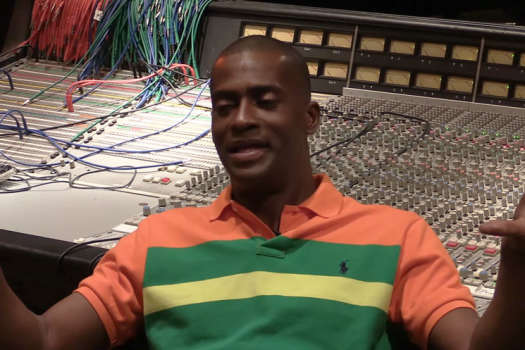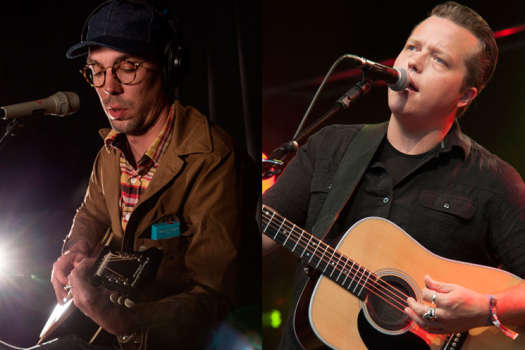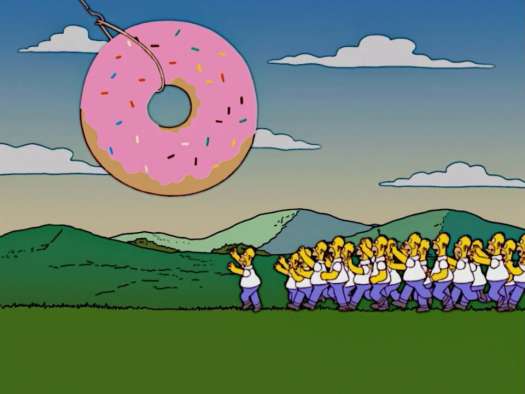Rather than trying to build one top ten list from the many disparate styles of electronic ambience, non-linear improv, experimental rock, avant jazz, droning noise and many more, we've asked the ten most frequent contributors to the Destination Out reviews section to write about one release that most excited them this year.
Avarus
II(HP Cycle)
The mysterious Finnish troupe Avarus roams, explores and sometimes burns down the outer catacombs of free-form psychedelias most fruitful areas freaky, good-humoured space-rock groove-outs, outsider folk commune shanties, minimal spiritualist drone prayers, lost art house film soundtracks Avarus tap all the right veins, keep things primitive and deceptively simple, and, as is especially so on II, the boys and girls in the band really set out to shake up conventions and each other with the colourful and constantly changing parts they play. Avarus II is as odd, wild, off-kilter, unpredictable and baffling an album as only a band reeling ahead on their own strengths could make. They really let the strange blood flow heavily on this one, making for quite possibly the wildest, most chaotic Avarus record in their steadily growing catalogue. Party! Kevin Hainey
Barnyard Drama
Im a Navvy (Barnyard)
Vibrational vistas unfold in soundscapes broad, bold and bluesy. Not only Barnyard Dramas most fully realised recording to date, my most rewarding listening experience this year, period. Im a Navvy is sonically adventurous, inviting listeners to roam in uncharted realms of the unconscious, turning sounds into Technicolor scenes redolent with drama and mystery. But the CD does more: its visceral, skronk-filled and gets feet thumping, as it builds off-kilter lines into engulfing waves of rhythm. Newly added guitarists with telepathic rapport, Justin Haynes and Bernard Falaise. sling the blues with a swampy, Ribot-ish angularity. And their added resources stoke vocalist Christine Duncan to unleash her formidable skills as a profoundly evocative lyricist and blues artist of jaw-dropping intensity. Jean Martins percussion, loops and turntables veer from playful to menacing and his producing skills have never been sharper. Navvy is just plain brilliant. Glen Hall
Kent Carter String Trio
Intersections (Emanem)
American jazz bassist Kent Carter was a key participant in the 60s free jazz revolution, then left for Europe, where he spent the 70s as Steve Lacys bassist and formed a lasting relationship with the legendary drummer John Stevens. None of which gives a hint of what Intersections sounds like: this is chamber music of a high order whose eloquent but understated beauty sinks in deeper with every listen. Compositions like "Blues Suite and "Pulapka suggest a hybrid between jazz and Renaissance and Baroque dance-forms, while the fully-improvised tracks have a Bartokian or Stravinskian flavour. Carter, violinist Albrecht Maurer and violist Katrin Mickiewicz fit together hand-in-glove, to the point where the groups intuitive, moment-to-moment interplay obliterates distinctions between improvisation and composition. Nate Dorward
Clogs
Lantern (Brassland)
On one level, every instrument in this quartet violin, viola, melodica and piano evokes a crystalline beauty with every pluck or vibrato, perfect in its seduction of your senses. But on a level beyond the notes, it is the dedication and musicianship that truly impresses. Clogs is a band that knows exactly what emotions and moods theyre trying to pull out of the listener, and Lantern is the pinnacle of this ambition. Every spin of this disc is a discovery of the joy of music through a disciplined and melodic experimentation of instruments and moods. Itll break the heart while igniting the brain. Chris Whibbs
Pierre Favre / Yang Jing
Two in One (Intakt)
This release is one of the few recorded success stories of music created by pairing a non-Western classical musician with a Western improviser; Yang Jings accomplished and spirited playing is met on common ground by Favres embracing yet forceful drumming. The dynamic range these two occupy is also highly varied with the drums and cymbals sounding notes and tones, and the pipa (a traditional Chinese string instrument) clicking and popping along like a small percussion set. While the overall effect seems to be that Favre is more flexible in his accommodations than Jing, Jings almost ornery virtuosity makes all nitpicking irrelevant. They meet, laugh, butt heads, share sweet lyricism and one cannot help but imagine the smiles that they may have shared as they played. Nilan Perera
Feuermusik
Goodbye, Lucille (Independent)
Torontos Feuermusik produced a truly stirring record out of a configuration that seems like a joke. Credited with "percussion, Gus Weinkaufs primary means of expression are buckets. Some may recognise Weinkaufs name from influential post-hardcore bands like Blake and Rockets Red Glare; if his shift to exploring buckets was met with incredulity from his peers, Weinkauf converted non-believers by sussing out the surprising sonic possibilities and throttling them for all theyre worth. Weinkaufs joined by former RRG member Jeremy Strachan, one of Canadas most talented multi-instrumentalists. Weinkaufs spastic attack propels Strachan, whose mesmerizing woodwinds and eclectic parts are layered upon each other to create astonishing horn sections. By surpassing the novelty of their instrumental make-up and tweaking math-rock and experimental jazz tags, Feuermusik unleashed a remarkably creative album with Goodbye, Lucille. Vish Khanna
Andy Haas / Don Fiorino
Death Dont Have No Mercy (Revenant)
Former Martha and the Muffins saxophonist Andy Haas had a busy year, releasing three excellent discs; Death Dont Have No Mercy is the strongest and most affecting. Haas takes on various wind instruments while Fiorino coaxes some strange stringed sounds from his arsenal. Haas is one of the most adept electronic manipulators around; his electronics arent the usual delay plus harmonizer settings, they act as a third lead instrument summing up both players contributions within a fearsome landscape. Songs on this album are positively chilling, with tunes sounding like the aural equivalent of crime scenes. And this disc is a disturbing rumination on violence and culture clashes. Haas and Fiorino have crafted a powerful anti-war statement without using any words. Age old slices of Americana like "Battle Hymn of the Republic and the national anthem itself gain poignancy with the juxtaposition of American-identified instruments (dobro, fife) with "foreign ones (Korean piri, North African lotar) suggesting an uneasy but fascinating coexistence of different worlds. David Dacks
Marsen Jules
Les Fleurs (City Centre Offices)
After all the post-whatevers and multi-tronica brandings, Dortmund, Germanys Martin Juhls slips off his nametag. As Marsen Jules he is a minimalist with themes that slowly overlap with resonance where micro and macro details blend and blur. Opening and closing with simple vibraphone figures that repeat and trail echoes at irregular intervals, Juhls coaxes organic wooziness from basic musical forms. As the album progresses, these gentle undulations propose an erasing of the artists hand; the illusion of a small watercraft filled with resonant instruments being played by the rising and falling tides. It is an album that belongs outdoors, the music is almost just overheard: "Coeur Saignant, a string quartet rehearsing on the high balcony of an enclosed courtyard; "Datura, a small harp endlessly echoing in watery catacombs; "Gueule de Loup, a subway trio playing against footsteps and distant trains. Juhls work is the soundtrack to a gardened city. Eric Hill
Svarte Greiner
Knive (Type)
Svarte Greiner, alter ego for Erik K. Skodvin, is best known as one half of the Nordic black-ambient duo Deaf Center, a prodigy within the ambient genre. Over the course of an EP and an album, the duo has established itself as the dark cross between the classical overtures of Angelo Badalamenti and the doom regeneration of Sunn O))). And so, in a stellar year that has seen fledgling labels like Type, Miasmah, Hapna, and others revitalise the long-worn ambient genre, Svarte Greiners Knive comes as icing on the cake. At its best, it sounds like the field recordings of an operatic ghost caught in a concert halls dank basement, stumbling over the forgotten instruments of a defunct orchestra. Skodvin excels at conjuring moods that stay with the listener long after the album ends. Knive is like little else out there: the soundtrack to ambients funhouse after dark. Dimitri Nasrallah
This Heat (This Is/ReR)
This was a fertile year for music, nothing grabbed me as much as this noisy collage that first took shape 30 years ago. This Heat is the long-awaited reissue of a 28-year-old album, yet it sounds more relevant now than it ever did. A clear influence on everyone from Liars to Hair Police, these Camberwall avant-punks dug deep into their gritty souls and pulled out something austere and revolutionary. Slipping through musical categorisation like wet soap, there is a distinct hunger for atonal supremacy. Through frantic drum looping and overdubbing, tribal punk trances, free jazz orgies and what could very well be the first collision between industrial and folk, its a murky expression by one of the eras most overlooked acts. Released both on its own and as part of the awe-inspiring Out of Cold Storage box set, this radical oeuvre is the sound of the road being paved for some of todays most innovative acts. Cam Lindsay
Avarus
II(HP Cycle)
The mysterious Finnish troupe Avarus roams, explores and sometimes burns down the outer catacombs of free-form psychedelias most fruitful areas freaky, good-humoured space-rock groove-outs, outsider folk commune shanties, minimal spiritualist drone prayers, lost art house film soundtracks Avarus tap all the right veins, keep things primitive and deceptively simple, and, as is especially so on II, the boys and girls in the band really set out to shake up conventions and each other with the colourful and constantly changing parts they play. Avarus II is as odd, wild, off-kilter, unpredictable and baffling an album as only a band reeling ahead on their own strengths could make. They really let the strange blood flow heavily on this one, making for quite possibly the wildest, most chaotic Avarus record in their steadily growing catalogue. Party! Kevin Hainey
Barnyard Drama
Im a Navvy (Barnyard)
Vibrational vistas unfold in soundscapes broad, bold and bluesy. Not only Barnyard Dramas most fully realised recording to date, my most rewarding listening experience this year, period. Im a Navvy is sonically adventurous, inviting listeners to roam in uncharted realms of the unconscious, turning sounds into Technicolor scenes redolent with drama and mystery. But the CD does more: its visceral, skronk-filled and gets feet thumping, as it builds off-kilter lines into engulfing waves of rhythm. Newly added guitarists with telepathic rapport, Justin Haynes and Bernard Falaise. sling the blues with a swampy, Ribot-ish angularity. And their added resources stoke vocalist Christine Duncan to unleash her formidable skills as a profoundly evocative lyricist and blues artist of jaw-dropping intensity. Jean Martins percussion, loops and turntables veer from playful to menacing and his producing skills have never been sharper. Navvy is just plain brilliant. Glen Hall
Kent Carter String Trio
Intersections (Emanem)
American jazz bassist Kent Carter was a key participant in the 60s free jazz revolution, then left for Europe, where he spent the 70s as Steve Lacys bassist and formed a lasting relationship with the legendary drummer John Stevens. None of which gives a hint of what Intersections sounds like: this is chamber music of a high order whose eloquent but understated beauty sinks in deeper with every listen. Compositions like "Blues Suite and "Pulapka suggest a hybrid between jazz and Renaissance and Baroque dance-forms, while the fully-improvised tracks have a Bartokian or Stravinskian flavour. Carter, violinist Albrecht Maurer and violist Katrin Mickiewicz fit together hand-in-glove, to the point where the groups intuitive, moment-to-moment interplay obliterates distinctions between improvisation and composition. Nate Dorward
Clogs
Lantern (Brassland)
On one level, every instrument in this quartet violin, viola, melodica and piano evokes a crystalline beauty with every pluck or vibrato, perfect in its seduction of your senses. But on a level beyond the notes, it is the dedication and musicianship that truly impresses. Clogs is a band that knows exactly what emotions and moods theyre trying to pull out of the listener, and Lantern is the pinnacle of this ambition. Every spin of this disc is a discovery of the joy of music through a disciplined and melodic experimentation of instruments and moods. Itll break the heart while igniting the brain. Chris Whibbs
Pierre Favre / Yang Jing
Two in One (Intakt)
This release is one of the few recorded success stories of music created by pairing a non-Western classical musician with a Western improviser; Yang Jings accomplished and spirited playing is met on common ground by Favres embracing yet forceful drumming. The dynamic range these two occupy is also highly varied with the drums and cymbals sounding notes and tones, and the pipa (a traditional Chinese string instrument) clicking and popping along like a small percussion set. While the overall effect seems to be that Favre is more flexible in his accommodations than Jing, Jings almost ornery virtuosity makes all nitpicking irrelevant. They meet, laugh, butt heads, share sweet lyricism and one cannot help but imagine the smiles that they may have shared as they played. Nilan Perera
Feuermusik
Goodbye, Lucille (Independent)
Torontos Feuermusik produced a truly stirring record out of a configuration that seems like a joke. Credited with "percussion, Gus Weinkaufs primary means of expression are buckets. Some may recognise Weinkaufs name from influential post-hardcore bands like Blake and Rockets Red Glare; if his shift to exploring buckets was met with incredulity from his peers, Weinkauf converted non-believers by sussing out the surprising sonic possibilities and throttling them for all theyre worth. Weinkaufs joined by former RRG member Jeremy Strachan, one of Canadas most talented multi-instrumentalists. Weinkaufs spastic attack propels Strachan, whose mesmerizing woodwinds and eclectic parts are layered upon each other to create astonishing horn sections. By surpassing the novelty of their instrumental make-up and tweaking math-rock and experimental jazz tags, Feuermusik unleashed a remarkably creative album with Goodbye, Lucille. Vish Khanna
Andy Haas / Don Fiorino
Death Dont Have No Mercy (Revenant)
Former Martha and the Muffins saxophonist Andy Haas had a busy year, releasing three excellent discs; Death Dont Have No Mercy is the strongest and most affecting. Haas takes on various wind instruments while Fiorino coaxes some strange stringed sounds from his arsenal. Haas is one of the most adept electronic manipulators around; his electronics arent the usual delay plus harmonizer settings, they act as a third lead instrument summing up both players contributions within a fearsome landscape. Songs on this album are positively chilling, with tunes sounding like the aural equivalent of crime scenes. And this disc is a disturbing rumination on violence and culture clashes. Haas and Fiorino have crafted a powerful anti-war statement without using any words. Age old slices of Americana like "Battle Hymn of the Republic and the national anthem itself gain poignancy with the juxtaposition of American-identified instruments (dobro, fife) with "foreign ones (Korean piri, North African lotar) suggesting an uneasy but fascinating coexistence of different worlds. David Dacks
Marsen Jules
Les Fleurs (City Centre Offices)
After all the post-whatevers and multi-tronica brandings, Dortmund, Germanys Martin Juhls slips off his nametag. As Marsen Jules he is a minimalist with themes that slowly overlap with resonance where micro and macro details blend and blur. Opening and closing with simple vibraphone figures that repeat and trail echoes at irregular intervals, Juhls coaxes organic wooziness from basic musical forms. As the album progresses, these gentle undulations propose an erasing of the artists hand; the illusion of a small watercraft filled with resonant instruments being played by the rising and falling tides. It is an album that belongs outdoors, the music is almost just overheard: "Coeur Saignant, a string quartet rehearsing on the high balcony of an enclosed courtyard; "Datura, a small harp endlessly echoing in watery catacombs; "Gueule de Loup, a subway trio playing against footsteps and distant trains. Juhls work is the soundtrack to a gardened city. Eric Hill
Svarte Greiner
Knive (Type)
Svarte Greiner, alter ego for Erik K. Skodvin, is best known as one half of the Nordic black-ambient duo Deaf Center, a prodigy within the ambient genre. Over the course of an EP and an album, the duo has established itself as the dark cross between the classical overtures of Angelo Badalamenti and the doom regeneration of Sunn O))). And so, in a stellar year that has seen fledgling labels like Type, Miasmah, Hapna, and others revitalise the long-worn ambient genre, Svarte Greiners Knive comes as icing on the cake. At its best, it sounds like the field recordings of an operatic ghost caught in a concert halls dank basement, stumbling over the forgotten instruments of a defunct orchestra. Skodvin excels at conjuring moods that stay with the listener long after the album ends. Knive is like little else out there: the soundtrack to ambients funhouse after dark. Dimitri Nasrallah
This Heat (This Is/ReR)
This was a fertile year for music, nothing grabbed me as much as this noisy collage that first took shape 30 years ago. This Heat is the long-awaited reissue of a 28-year-old album, yet it sounds more relevant now than it ever did. A clear influence on everyone from Liars to Hair Police, these Camberwall avant-punks dug deep into their gritty souls and pulled out something austere and revolutionary. Slipping through musical categorisation like wet soap, there is a distinct hunger for atonal supremacy. Through frantic drum looping and overdubbing, tribal punk trances, free jazz orgies and what could very well be the first collision between industrial and folk, its a murky expression by one of the eras most overlooked acts. Released both on its own and as part of the awe-inspiring Out of Cold Storage box set, this radical oeuvre is the sound of the road being paved for some of todays most innovative acts. Cam Lindsay




